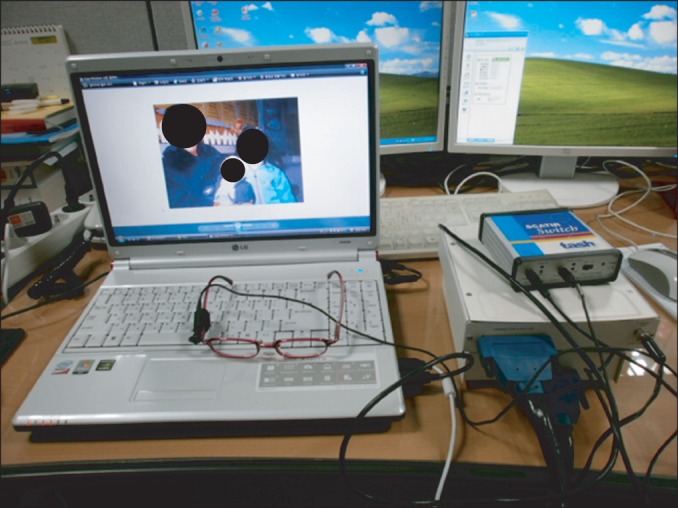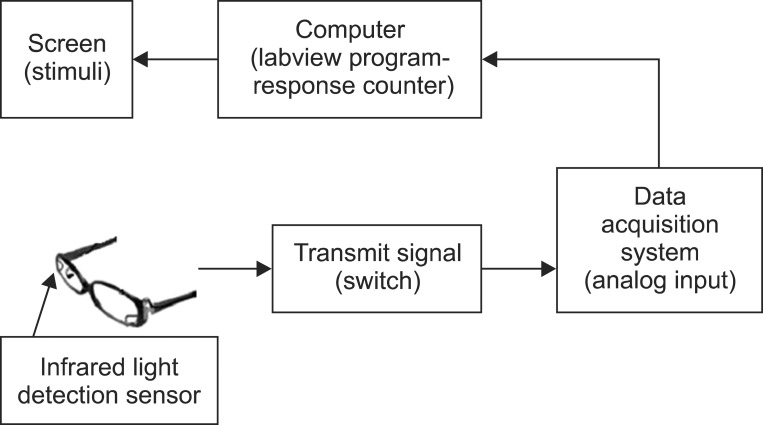Ann Rehabil Med.
2012 Jun;36(3):428-431. 10.5535/arm.2012.36.3.428.
A Learning Set Up for Detecting Minimally Conscious State (MCS)
- Affiliations
-
- 1Department of Rehabilitation Medicine, National Rehabilitation Hospital, Seoul 141-070, Korea. lovingtous@naver.com
- 2National Rehabiliation Research Institute, Seoul 141-070, Korea.
- KMID: 2266753
- DOI: http://doi.org/10.5535/arm.2012.36.3.428
Abstract
- Detecting signs of learning in persons diagnosed to be in a post-coma vegetative state and minimally conscious state (MCS) may modify their diagnosis. We report the case of a 65-year-old female in a vegetative state. We used microswitch-based technology that is based on patient response to eye-blinking. We followed an ABABCB design, in which A represented baseline periods, B intervention periods with stimuli contingent on the responses, and C a control condition with stimuli presented non-contingently. We observed the level of response during the B phases was higher than the level of A and C phases. This indicated the patient showed signs of learning. This state was confirmed by an evaluation through the Coma Recovery Scale-Revised (CRSR) score, and after completion of this study her CRSR score changed from 4 to 10. We believe microswitch technology may be useful to make a diagnosis of MCS and offer new opportunities for education to MCS patients.
Figure
Reference
-
1. Giacino JT, Ashwal S, Childs N, Cranford R, Jennett B, Katz DI, Kelly JP, Rosenberg JH, Whyte J, Zafonte RD, et al. The minimally conscious state: definition and diagnostic criteria. Neurology. 2002; 58:349–353. PMID: 11839831.
Article2. Schnakers C, Vanhaudenhuyse A, Giacino J, Ventura M, Boly M, Majerus S, Moonen G, Laureys S. Diagnostic accuracy of the vegetative and minimally conscious state: clinical consensus versus standardized neurobehavioral assessment. BMC Neurology. 2009; 9:35. PMID: 19622138.
Article3. Lancioni GE, Singh NN, O'Reilly MF, Sigafoos J, Didden R, Oliva D, Calzolari C, Montironi G. A learning setup for a post-coma adolescent with profound multiple disabilities involving small forehead movements and new microswitch technology. Disabil Rehabil Assist Technol. 2007; 2:293–297. PMID: 19263535.
Article4. Giulio E, Marta O, Claudia C, Maria T, fabrizio S, Nirbhay N, mark F, Jeff S, Doretta O. Learning in post-coma persons with profound multiple disabilities: two case evaluations. J Dev Phys Disabil. 2008; 20:209–216.
Article5. Giacino JT, Kalmar K, Whyte J. The JFK Coma Recovery Scale-Revised: measurement characteristics and diagnositic utility. Arch Phys Med Rehabil. 2004; 85:2020–2029. PMID: 15605342.6. Andrews K, Murphy L, Munday R, Littlewood C. Misdiagnosis of the vegetative state: retrospective study in a rehabilitation unit. BMJ. 1996; 313:13–16. PMID: 8664760.
Article7. Luaute J, Maucort-Boulch D, Tell L, Quelard F, Sarraf T, Iwaz J, Boisson D, Fischer C. Long-term outcomes of chronic minimally conscious and vegetative states. Neurology. 2010; 75:246–252. PMID: 20554940.
Article8. Giolio E, Mark F, Nirbhay N, Doretta O, Mauro M, Gianluigi M. A new microswitch to enable a boy with minimal motor behavior to control environmental stimulation with eye blinks. Behav Intervent. 2005; 20:147–153.
- Full Text Links
- Actions
-
Cited
- CITED
-
- Close
- Share
- Similar articles
-
- Assessment of Patients with Minimally Conscious State: Recent Advances
- A Method for Estimation of the Life Expectancy for the Persistent Vegetative State and Minimally Conscious State after Craniocerebral Trauma in Korea
- Emerging Therapies in Vegetative and Minimally Conscious State after Brain Injury
- Clinical and neuroimaging determinants of minimally conscious and persistent vegetative states after acute stroke
- Prolonged Disorders of Consciousness




